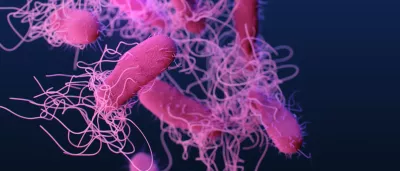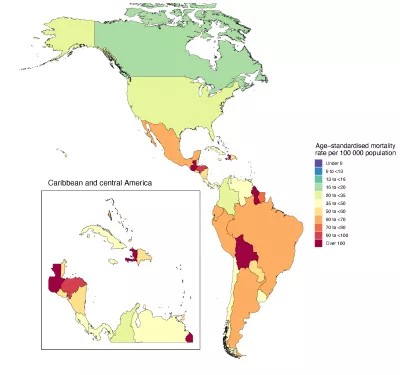Saving children from antibiotic-resistant infections
Published October 24, 2023

Photo by James Archer, CDC.
Children are some of the most vulnerable to antibiotic-resistant infections as their immune systems are weaker.
An interview with Dr. Gisela Robles Aguilar, the first author of a recent IHME-led study on antibiotic resistance in the WHO Region of the Americas and a Global Burden of Disease researcher at the University of Oxford. The study, which is the most comprehensive study of drug-resistant bacteria in the region, found that antibiotic resistance was associated with more than two out of every five infection-related deaths in the Americas.
IHME: Your research has shown that drug resistance is a growing threat throughout the world, especially for children. What is driving these trends?
Dr. Gisela Robles Aguilar: The increased use of antibiotics is causing us to find more bacteria that are resistant to these antibiotics. The newest antibiotic was developed in the 1980s — the newest antibiotic class — and no other new class has been developed since then. We are in a race against time. The more we depend on those antibiotics, the more likely we are to find bacteria that have developed mechanisms to defend themselves against those antibiotics.
IHME: Which children are most at risk for developing antibiotic-resistant infections and why?
Dr. Gisela Robles Aguilar: People with vulnerable immune systems are most at risk, especially very young children. Children who have just been born — neonates — have low capacity to defend themselves against any bacteria that enter their environment. As children grow and develop, they would potentially be breastfed and develop their immune systems and then be able to protect themselves, but at an early age they are vulnerable.
Other groups are vulnerable, too, such as people at older ages, when the immune system tends to weaken. Also, there are people who have their immune system weakened at other ages, such as individuals who have had surgery or other health care interventions that put them at risk of developing infections.
IHME: What can parents and caregivers do to protect their kids from antibiotic-resistant infections?
Dr. Gisela Robles Aguilar: At early ages, it’s being aware of infection and prevention control measures and having access to clean water and sanitation. In countries where this is somehow compromised, not everyone would have access to basic measures of preventing infections. The pool of infections that people can get is larger. Therefore, it is easier for them to develop an antibiotic-resistant infection.
Also, vaccination campaigns are a good way of preventing infections. Fortunately, there are vaccines available for young children that would prevent these infections and therefore prevent the bacteria from becoming resistant to antibiotics because of being treated.
IHME: On the topic of vaccinations, I noticed that in your study, you said that vaccines only exist for two of the most lethal antibiotic-resistant bacteria, pneumococcal disease and tuberculosis. Why don’t we have vaccines for more of these bacteria?
Dr. Gisela Robles Aguilar: There are some vaccines that are already being developed and tested to enter the pipeline to be recommended for wider use nationally and internationally. But one of the biggest problems was the fact that there was no information on the burden of disease that these bacteria created. Vaccinations for Streptococcus pneumoniae are well known and available internationally. But for instance, for bacterial pneumonia, which is one of the infections that is prominent among neonatal sepsis deaths, vaccines have been developed, but it was unknown how many deaths this intervention would prevent. This information was not present in the past, but now we are estimating the number of deaths that could be prevented with other vaccines so that we can push to bring these vaccines to the public as soon as possible.
We are in a race against time. The more we depend on those antibiotics, the more likely we are to find bacteria that have developed mechanisms to defend themselves against those antibiotics.
IHME: Do you feel like policymakers are listening?
Dr. Gisela Robles Aguilar: Yeah. I think there is momentum for them to listen, especially after COVID. We know that they are more receptive to opportunities to prevent not only national infections but also international infections that can affect the whole world. Policymakers are more receptive to those ideas than in the past.
IHME: Overall, what strategies for combating antibiotic-resistant threats hold the most promise in your opinion?
Dr. Gisela Robles Aguilar: WHO published a strategy that champions infection prevention and control. That is the first pathway in which we expect antimicrobial resistance to grow, so campaigns to promote access to water and sanitation and vaccination would be important. Other aspects would be keeping track of antibiotics being used in hospitals and by doctors and general practitioners, as well as those being sold in pharmacies, and knowing the consumption of antibiotics, nationally and internationally. This would allow us to track the resistance that is being developed when we use those antibiotics. It would help us optimize or be strategic about the way that antibiotics are used, keeping track of the levels of resistance to an antibiotic. When levels of resistance are too high, we would be able to switch or offer alternative antibiotics.
IHME: You had mentioned that the last class of antibiotics had only been developed in the 1980s. What are the barriers?
Dr. Gisela Robles Aguilar: There’s a recommendation from WHO to increase the amount of energy and resources devoted to developing new antibiotics, not only in industry but also in countries with governments financing research to develop new antibiotics. These discussions are even more relevant after the experience of the pandemic in which we are discussing an international effort to develop antibiotics. This has a solid foundation after seeing how vaccines were developed for COVID-19.
IHME: I was fascinated by the different examples of high-performing countries in the Americas that you highlighted in your study. You highlighted Chile, Colombia, Costa Rica, and the US as having some of the lowest levels of death from drug-resistant infections in the Americas. What are these countries doing to combat infections?
Dr. Gisela Robles Aguilar: I think, first, it is careful use of antibiotics. We know in those countries that it is difficult for people to access antibiotics without prescriptions, which is not the case in the rest of the countries in Latin America. But in Chile, Colombia, Costa Rica, and the US, we know that access to antibiotics is closely followed. Then, secondly, infection prevention and control: those countries have good ways of preventing infections in hospitals and have low neonatal mortality to begin with.
Deaths per 100,000 people (age-adjusted) associated with antibiotic resistance in the WHO Region of the Americas, 2019

Source: Dr. Gisela Robles Aguilar, IHME.
IHME: In your paper, you mentioned that infants had the highest death rates from drug-resistant infections in countries including the Dominican Republic and Venezuela. Can you give me a better idea of what factors are driving these trends?
Dr. Gisela Robles Aguilar: Conversely, some of the factors affecting these are the high levels of infections to begin with and higher neonatal deaths. Approximately a quarter of neonatal deaths are due to an infection.
IHME: Is the use of antibiotics also a factor in those countries?
Dr. Gisela Robles Aguilar: Yes. However, in some countries in the Americas, access to antibiotics is also very limited, such as in Haiti, Guatemala, Bolivia, and Peru, especially access to tuberculosis treatment. Preventing infections in these countries is probably the low-hanging fruit in terms of combating antimicrobial resistance because people have less access to antibiotics.
IHME: Do you think that the international community could play a role in expanding access to antibiotics that are needed in these countries?
Dr. Gisela Robles Aguilar: Yes, definitely. We know that sometimes the most basic antibiotics could be useful to treat most of the infections, but if they are not available to the public in these countries, then people may access other antibiotics which should be put in a reserve or put into careful use since bacteria have developed resistance to them. One example is penicillin, which was the first antibiotic that was discovered and developed. However, there are shortages of penicillin in some countries in the Americas. Many bacterial infections could be treated with penicillin if available, which preserves the usage of complex antibiotics for more complex infections. But in Latin America, infections are often treated with antibiotics which are more complex than penicillin.
